

To understand the Emperor card of the tarot, we must go back to the origins of imperial power in Europe. The Holy Roman Empire, founded with the coronation of Charlemagne in 800, lasted more than a thousand years until its dissolution by Napoleon in 1806. This institution embodied the continuity of the ancient Roman Empire and represented God's secular authority on earth.
The process to become emperor was complex and symbolic. A king of Germania was first designated emperor-elect by his Germanic aristocratic peers. He then traveled to Milan to receive the Iron Crown of Lombardy and the title of king of Italy. Finally, he continued his journey to Rome where the Pope crowned him emperor during a solemn investiture ceremony.
In theory, the Pope and the Emperor cooperated to extend divine authority on earth. In reality, they kept Italy at war for centuries, fighting over territories and authority over bishops and abbots. The cities, craftsmen's corporations and great families chose their side in this permanent struggle for power.
This historical tension between spiritual power and temporal power is reflected in the iconography of the Emperor of the tarot. The first card creators drew from this political reality to create an archetype that goes beyond the simple representation of a sovereign. The Emperor of the tarot thus embodies earthly authority in all its complexity: protective and structuring, but also potentially rigid and dominating.
The first Emperor clearly identifiable in tarot history appears in the Visconti di Modrone deck, one of the oldest known ancestors of tarot, dating from around 1442. This card represents Emperor Sigismund, who died in 1437, recognizable by his characteristic forked beard that we find in portraits of the time, notably the one painted by Albrecht Dürer.
This representation is not by chance. Gian Galeazzo Visconti had been named first Duke of Milan in 1395 after paying a considerable sum to Wenceslaus, Sigismund's elder brother who was then emperor-elect. Later, Duke Filippo Maria Visconti, son of Gian Galeazzo, commissioned this luxurious hand-painted deck for his daughter's marriage. It is likely that he wanted to honor Emperor Sigismund in this card, thus recognizing the political links between his family and the Empire.
The Emperor of this ancient deck already presents the traditional attributes we know: the command staff and the globe symbolizing temporal and spiritual powers, as well as the imperial eagle. However, in this version, the eagle adorns a fan-shaped hat rather than the usual shield, showing the artistic variations of the time.
This historical card establishes a direct link between real political figures and tarot archetypes. It reminds us that tarot creators drew inspiration from the world around them to give life to universal symbols.
Only the master craftsman of the Paris tarot allows himself a variation by representing the Emperor standing (just as he did for the Empress). It is mainly about representing the character, in a classical way, as was done in antiquity. That said, he is represented here with complete armor, even if it seems ceremonial. The engraver seems to have wanted to depict a warrior and conquering man rather than a managing politician. It is true that the construction of an empire has always been made of multiple conquests and annexations.
Jean Noblet shows the Emperor with a shield (like the Empress), raising the same question as for the Empress: Is Jean Noblet the first engraver to have depicted the Empress and the Emperor with this attribute. With his worn coat of arms and the hand holding the belt, the Emperor of the Marseille Tarot emphasizes the accumulation of experience and lessons and the skills that one draws from them to establish one's power.
The Emperor of the Marseille Tarot with his coat of arms resting at his feet, and not dressed in armor, is more associated with the father or a paternal figure, emphasizing his protective and benevolent aspect.
The Emperor also has a helmet and not a hat, while he does not wear armor. The headgear extends in an exaggerated way in the back, suggesting a particular intention of the engraver. It is quite possible that Jean Noblet wanted to signify the fragility or flaw of the Emperor, unable to see blows coming from behind. We can relate this vision to the expression "Achilles' heel" coming from Greek mythology.
The position of the Emperor's crossed legs deserves particular attention. This posture was traditionally reserved for the person of highest status in an assembly or a judge about to render sentence. By adopting this relaxed but authoritative position, the Emperor shows that he is both in total control of the situation and perfectly comfortable in his role as leader.
The globe that the Emperor holds in many historical versions is not a simple decorative ornament. It is a representation of T-O maps (Orbis Terrarum), the medieval vision of the world that dominated European geography until the great discoveries. These diagrams showed the Earth as a flat disk surrounded by the ocean, with the three known continents - Europe, Asia and Africa - separated by a T formed by the Mediterranean and the Don and Nile rivers.
In this conception of the world, Jerusalem occupied the exact center of the Earth, reflecting the medieval Christian vision where the Holy Land constituted the spiritual and geographical heart of creation. The Orient (from which comes the word "orientation") was at the top of these maps, where the sun rises and where the earthly Paradise was located. This organization was not only geographical but deeply theological.
When the Emperor holds this T-O globe, he does not only manifest his power over a territory, but his authority over the entire Christian world as conceived at the time. The fact that this globe is often topped with a cross reinforces this dimension: the Emperor reigns over the Earth in the name of Christ, unifying temporal power and spiritual mission.
This symbolism explains why the Emperor of the tarot goes beyond the simple figure of the king or political leader. He embodies the cosmic order itself, the divine structure that organizes and governs the material world according to a higher plan. Even when cards evolve and the globe loses its geographical details, this dimension of universal authority remains at the heart of the imperial archetype.
Finally, of all the Marseille Tarots, Jean Noblet's is the only one where the Emperor is turned to the right. Subsequently they will all be turned to the left.
Jean Dodal's version has two atypical details. The first is a number 4 engraved in front of the Emperor's face. This symbol which could evoke the shape of a square (that of the builder) could simply remind us that Jean Dodal was initiated by a master. Jean Noblet did the same by writing "LL BATELEUR" instead of "LE BATELEUR". This desire of Dodal and Noblet to show their belonging to the corporation of master craftsmen illustrates well the importance of companionship at this time. Much more than a relationship between a master and his apprentice, companionship had its traditions, codes and rituals and formed a real community. More than transmitting know-how, masters also transmitted a philosophy, a way of being. The Marseille Tarot represents its quintessence.
The second detail is undoubtedly the Emperor's necklace in the shape of a goose head. Its interpretation is not so obvious. The goose head could have several symbolic interpretations. In some cultures, the goose is considered a symbol of vigilance and protection. It could also represent fidelity or travel, as geese migrate over long distances while remaining faithful to their group. However, it is quite possible that Dodal wanted to make a connection with the game of the goose. It is considered the prototype of many commercial racing board games of later centuries in Europe. It gained great popularity in the 16th century. The game is mainly played in Europe and is considered family entertainment. This game is an allegory of life's path, with its successes and achievements. It is possible that Dodal wanted to tell card players that the series of 22 trumps was to be viewed as a whole as a true spiritual journey.
The imperial eagle on the shield in this version also deserves our attention. In the first Italian tarots, the double-headed eagle symbolized the temporal and spiritual powers of the emperor. Its progressive simplification in French versions probably reflects a desire to avoid emphasis on Germanic influence in Italy, territory then disputed between different European powers.
The history of Bolognese tarot offers us a fascinating example of how politics can transform card iconography. Bologna had a unique 62-card deck called Tarocchino, still popular today among Italian card players. This version had removed four pip cards from each suit and featured images borrowed from the famous Charles VI deck created for the Este dukes of Ferrara.
In 1725, a minor political incident had lasting consequences on Bolognese tarot. Bologna was then a papal state administered by a Cardinal-Legate representing the Pope, who had considerable authority over taxes, the army and justice. Unlike other papal states, Bologna had the privilege of having a senate. Theoretically, there was a balance of power between the legate and the senate, but in reality, the senate was quite weak and the legate constantly sought to remove all authority from it.
The legate flew into a terrible rage when Bologna was described as having a "mixed" government in a geographically-themed tarot deck. He had all the craftsmen who had been hired to engrave and print the deck arrested, and decreed that henceforth the Empress, the Emperor, the Popess and the Pope of the tarot would be replaced by four Moors.
These Moors have since been the distinctive characteristic of Bolognese tarot. In modern versions, they are almost identical, differing only in the number of arrows or spears they hold. But some of the earliest decks gave more personality to the Moors. The Al Mondo deck from the mid-1700s shows the Moors holding symbolic objects that allude to their origins as secular or religious figures. The Moor who replaces the Emperor holds a scepter topped with the sun, indicating that this is a masculine and secular figure.
After the French Revolution of 1789, golden crowns and the heads that wore them were no longer politically correct. This situation lasted until Napoleon proclaimed himself emperor and brought crowns and imperial insignia back into fashion. For decades, French printers were forced to modify their wooden plates to eliminate imperial symbolism from their cards.
The Emperor temporarily became "Grandfather," losing all his royal attributes. His crown was replaced by what looks like a nightcap with a pompom. He held a flower instead of a scepter, and the imperial eagle completely disappeared from his shield. The headgear nevertheless kept the same characteristic flared edge, showing that engravers tried to preserve the essence of the character while removing its monarchical references.
The card presented here was printed by François Isnard in the 1760s and modified by a later printing workshop during or just after the revolution of 1793. Curiously, someone who was not satisfied with this change wrote "L'Empereur" at the bottom of the card, testifying to popular resistance to this forced transformation.
This revolutionary period perfectly illustrates the plasticity of tarot archetypes in the face of political upheavals. Even deprived of his symbols of power, the patriarchal and protective essence of the character remained intact under the name "Grandfather". Within a few decades, political fortunes changed, and decks quickly regained their original Marseille Tarot pattern.
In the 19th century, French occultists like Éliphas Lévi, Oswald Wirth and Papus revolutionized tarot interpretation by adding esoteric and cosmic dimensions to it. They kept the image of the Marseille Tarot but superimposed their own deep symbolic readings on it.
These thinkers saw in the Emperor's body a triangle formed by his torso, while his legs drew a cross. This geometric combination represents the symbol of alchemical sulfur, evoking the spirit that dominates matter. For them, the Emperor embodied this spiritual mastery over the physical world.
Oswald Wirth particularly developed this vision in his 1887 card. His Emperor holds a scepter topped with a lotus flower and sits on a stone cube, the very essence of stability and fixed energy. The traditional globe topped with a cross, symbol of the emperor's temporal and spiritual power, was reinterpreted as the astrological sign of Venus, emphasizing concepts of birth and creation.
In this esoteric approach, the Emperor becomes much more than an earthly sovereign. He represents the creative fire at the heart of all beings, but also this creative energy imprisoned in matter. The red of his robe, dominant color of Emperors in the Marseille Tarot, symbolizes this inner fire that animates all creation.
When the British occultists of the hermetic order of the Golden Dawn reorganized the correspondences between the Hebrew alphabet and tarot cards, the Emperor was assigned the letter Hé (window) as well as the astrological correspondences of Aries and Mars. He then became known by the title "Son of the Morning" and acquired a pronounced martial dimension: energetic, courageous, ambitious, victorious conqueror.
This new astrological attribution profoundly transformed the interpretation of the card. Aries brings the initiating energy, the first impulse that launches projects, while Mars provides the strength necessary to carry them through. Decks influenced by the Golden Dawn now use the color red and ram heads to emphasize this link with Martian energy.
The number 4 also took on particular importance in this interpretation. The quaternary was associated with the four seasons, the four elements, the four directions, evoking a feeling of completeness and totality. The Emperor thus became the master of natural cycles and elemental forces that govern the material world.
Arthur Edward Waite and Pamela Colman Smith closely followed the teachings of the Golden Dawn when creating their card. The ram heads that adorn the square throne reinforce the link with Aries and Mars, while the deep red cloak emphasizes Martian energy. This Emperor no longer has the attributes of the Holy Roman Empire: he has lost the imperial eagle and his shield, and his orb is in plain gold rather than the terrestrial globe topped with a cross. Behind him, we can see mountains, representing stability and permanence. The predominant red color of his outfit symbolizes energy, passion and power.
For an Egyptian touch, the traditional symbols of the orb and scepter have been combined into an Ankh (ansate cross), symbol of life force, sun and fertility. The Emperor faces the reader and his legs are no longer crossed but armored, completely removing French alchemical and astrological symbolism.
According to Waite, this monarch goes beyond the simple earthly ruler. He is the Lord of Thought sitting on a throne of intellect, a paternal figure who counterbalances the Empress. The mountains and river behind the Emperor are unique to this version. They could evoke the spiritual heights to climb, or the hostile nature that the Emperor governs, as opposed to the fertile nature over which the Empress presides.
Bruno De Nys offers an interesting emperor since he dominates what could be the Great Wall of China. Naturally this imposing construction reminds us of the character's abilities to undertake and succeed on the material level. This immense enclosure can also be seen as a limit for the character, a framework that he cannot exceed. This is a convincing representation of one of the paradoxical aspects of this card.
I like less however the throne with a dog-headed armrest, probably inspired by ram heads from the same card in the Rider-Waite-Smith tarot. I imagine that Bruno de Nys wanted to highlight the aspects of fidelity and loyalty, symbol of the dog, rather than the energy and initiative aspect of the ram. But is an emperor or even a sovereign really faithful and loyal? His vassals certainly, but the overlord himself? Curious point of view from the card maker. Similarly, the coat of arms is here represented intact, while the worn, holed and dented aspect of historical tarots is so meaningful, a pity to have abandoned this idea.
I love these roots that sink deep into the ground, sign of the Emperor's anchoring in materiality. I like less the bare branches, as if identical to the roots, rising in the same way into the sky. The Emperor is not a celestial man, he pursues no spiritual ideal, he only seeks material expansion.
I also like the shoots that emerge from the ground. They illustrate the way the Emperor spreads his vitality, ensures providence and protects his own. This symbol is however ambiguous because it could also perfectly evoke the emergence of abundant life in the Empress.
The tiny owl in its hole is interesting, because it could be the emperor sitting in his tree, his world. He is so small in the card, that he can remind us that however great the Emperor's glory, he remains nonetheless a man, fragile and mortal.
The presence of the sun on the horizon behind the tree is strange. Is it rising or setting? The fact remains that the Emperor represents a man at the height of his glory, it would have been better if the sun were in full sky. Other tarot cards can better evoke birth or death.
I don't know if Napoleon is truly perceived as a positive character abroad. Even in France, the man is not so glorified. If you ask a French person to name a battle from Napoleon's reign or even a famous battle, there's a good chance they'll cite the Battle of Waterloo, which was Napoleon Bonaparte's final defeat. Yet the skilled strategist won many battles and had several brilliant moments in conquering Europe. In France, we even have the expression "c'est la Bérézina" used to signify a total rout, a disaster or a catastrophic situation. It takes its origin from the Battle of Berezina which took place during the Russian campaign.
In this card, I especially like the light bulb that illuminates this man appearing to be made of marble. The character is partly frozen, sclerotic, and even cracked. Thus under the glory conveyed by the costume, and the aura of the medal worn proudly, hides a man as if immobilized by a straitjacket. His convictions, his self-esteem, his vanity crack his being and prevent him from evolving and transcending himself.

Key words for the 78 cards for the Tarot of Marseille and the Rider-Waite-Smith, to slip into your favorite deck. Your leaflets always with you, at hand, to guide you in your readings. Thanks to them, your interpretations gain in richness and subtlety.
Well, it's true that an emperor is an imposing character who normally reflects social success, that's undeniable, but also an accumulation of power and wealth. However in the context of the fool's journey, the Emperor is only at the 4th position, a long road remains to be traveled to reach the 22nd position of the World card. Also the Emperor remains a solitary character, he has not yet experienced the stage of the Lovers. The monarch is still in survival mode, he has not opened up to the world. Even if finally he has made his hole and his place, he has remained in his bubble. Prosperity, even material, only comes with the Chariot card where the prince goes to conquer the world after discovering it with the Lovers. And he will finally reap what he has sown, just after, with the Justice card.
The Emperor masters his know-how, but he only reproduces what works, without evolving, without progressing. He only succeeds and flourishes in the place given to him, no more no less. The Emperor is not a visionary, has no greatness, he just masters and applies the norms. In my opinion, true prosperity comes when we exceed our limits, when we go further than others, further than the norm. Thus full abundance will begin with the Chariot and be realized with Justice.
| Symbolic interpretation | Right direction (Positive) | Solidity, realism, organization, concentration, protection, tradition, habit, command, law, rule, framework, security, control | Reverse direction (Negative) | authority, slowness, routine, maladjustment, paternalism, abuse of power, stagnation, conformism |
| Psychological interpretation | Right direction (Positive) | Organized, Producer, Pragmatic, Voluntary, Responsible, Mature | Reverse direction (Negative) | Disorganized, Rigid, Intransigent, Intolerant, Touchy, Proud |
| Advice | |
| Trust yourself. Be logical. Apply the rules. Results come with hard work. Order sparingly. Follow the adage: an iron hand in a velvet glove. | |
| Thematic Interpretation | Love | Solid, lasting relationship. A feeling that develops over the long term. Reassuring and protective agreement (too much?). Possessive partner | Work | Job search success. Project success. Position of responsibility. Paternalistic atmosphere. Rigid hierarchy | Money | Significant long-term benefits. Results that match the investment. Guarantee or surety from family and friends. Investment blocked or not matured | Family / Friendships | Growing relationship. Strong atmosphere or (excessive?) paternal authority. Factual or standardized exchanges. Routine family life. Family straitjacket | Health | Stable, balanced life. Good living. Overeating. Need to return to reality. Desire to procreate. Weary daily life |
| Divination / Prediction | Who ? | A father. A mature man. A Cartesian and competent man. A man of power. A boss | Where ? | A company. An association. The army. A public or state establishment. A place of power | When ? | A business meeting. A political rally. An election. During a project or mission | How ? | By doing what you've learned. Applying the rules. Taking the lead. Motivating and leading the team |
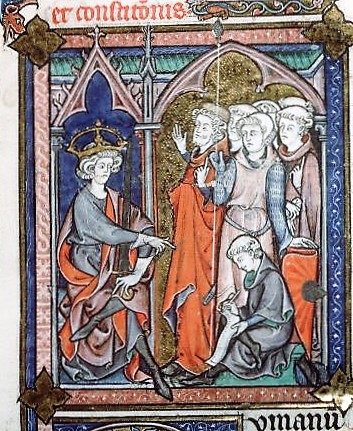


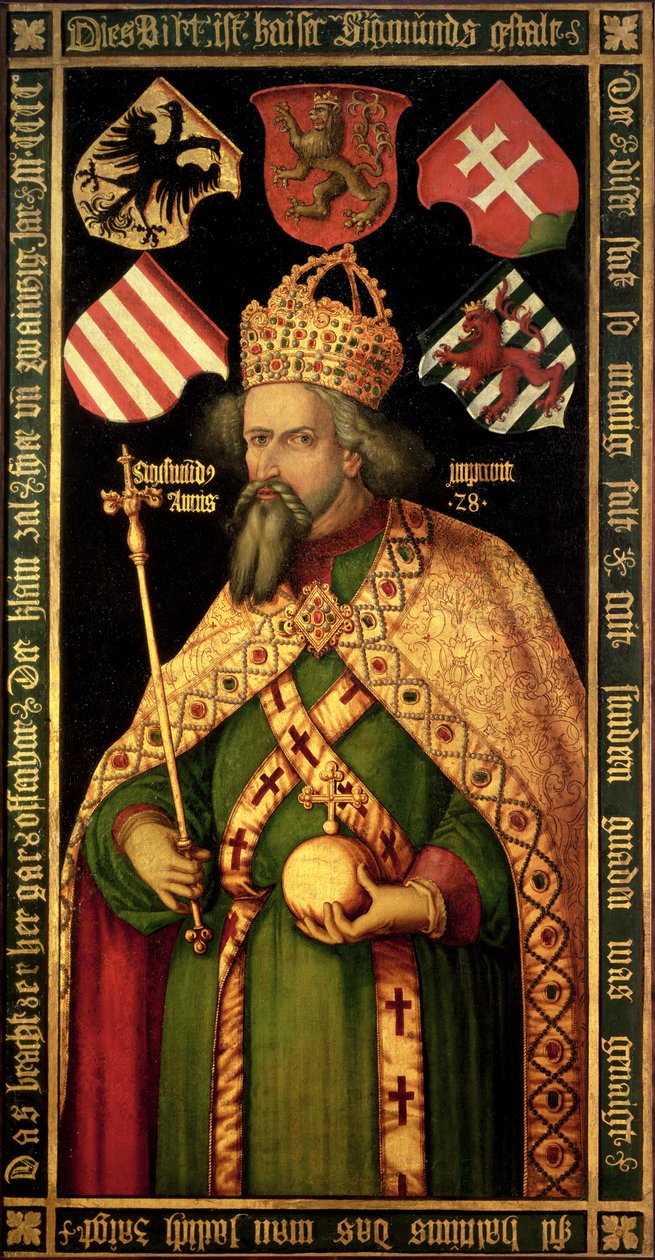
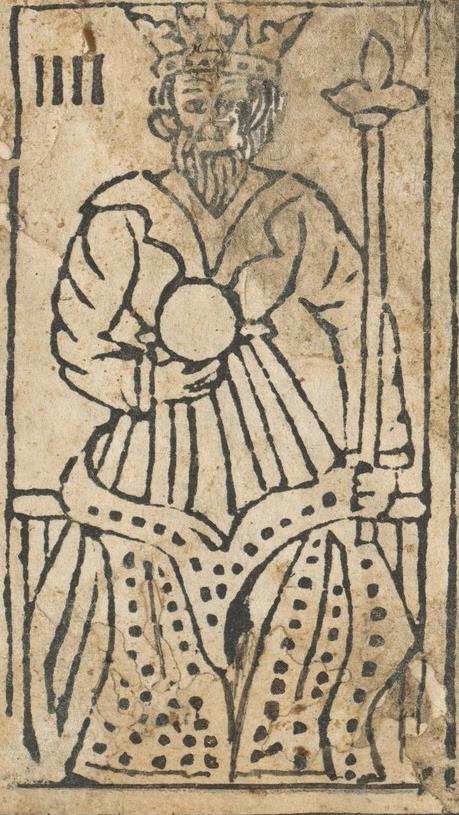
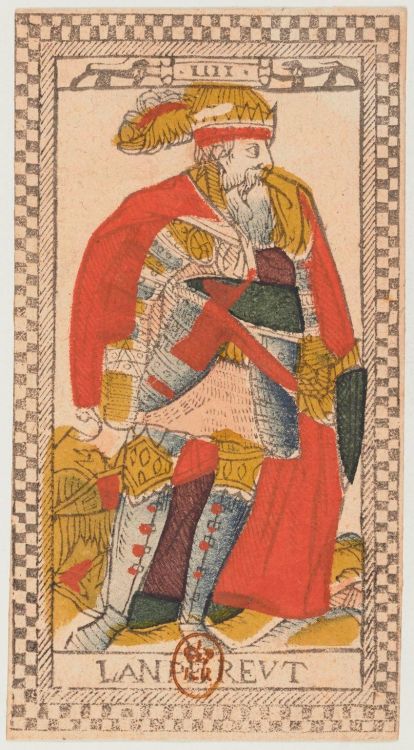

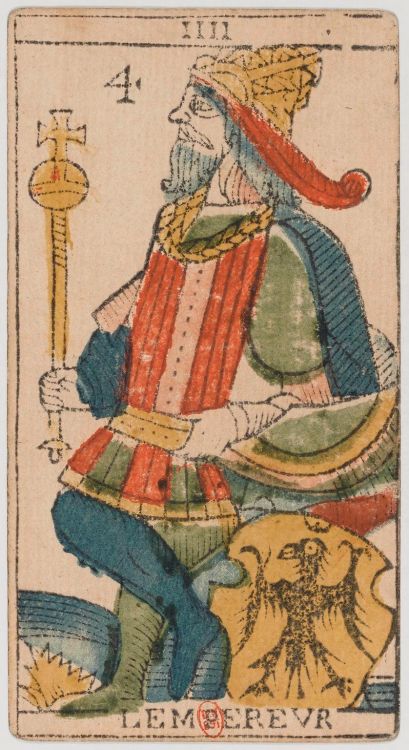
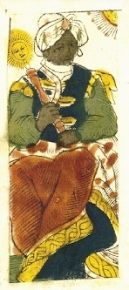
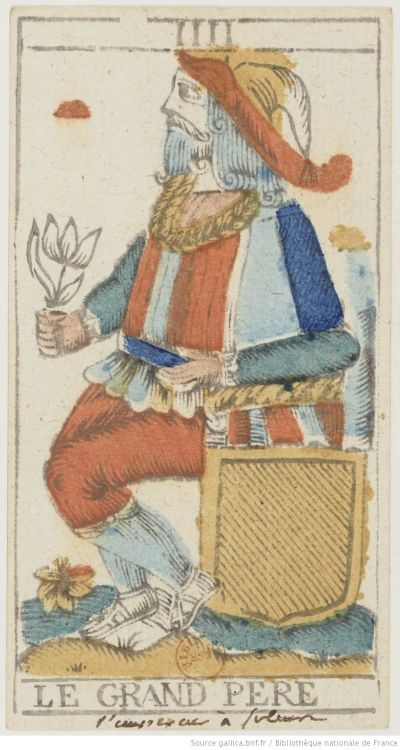
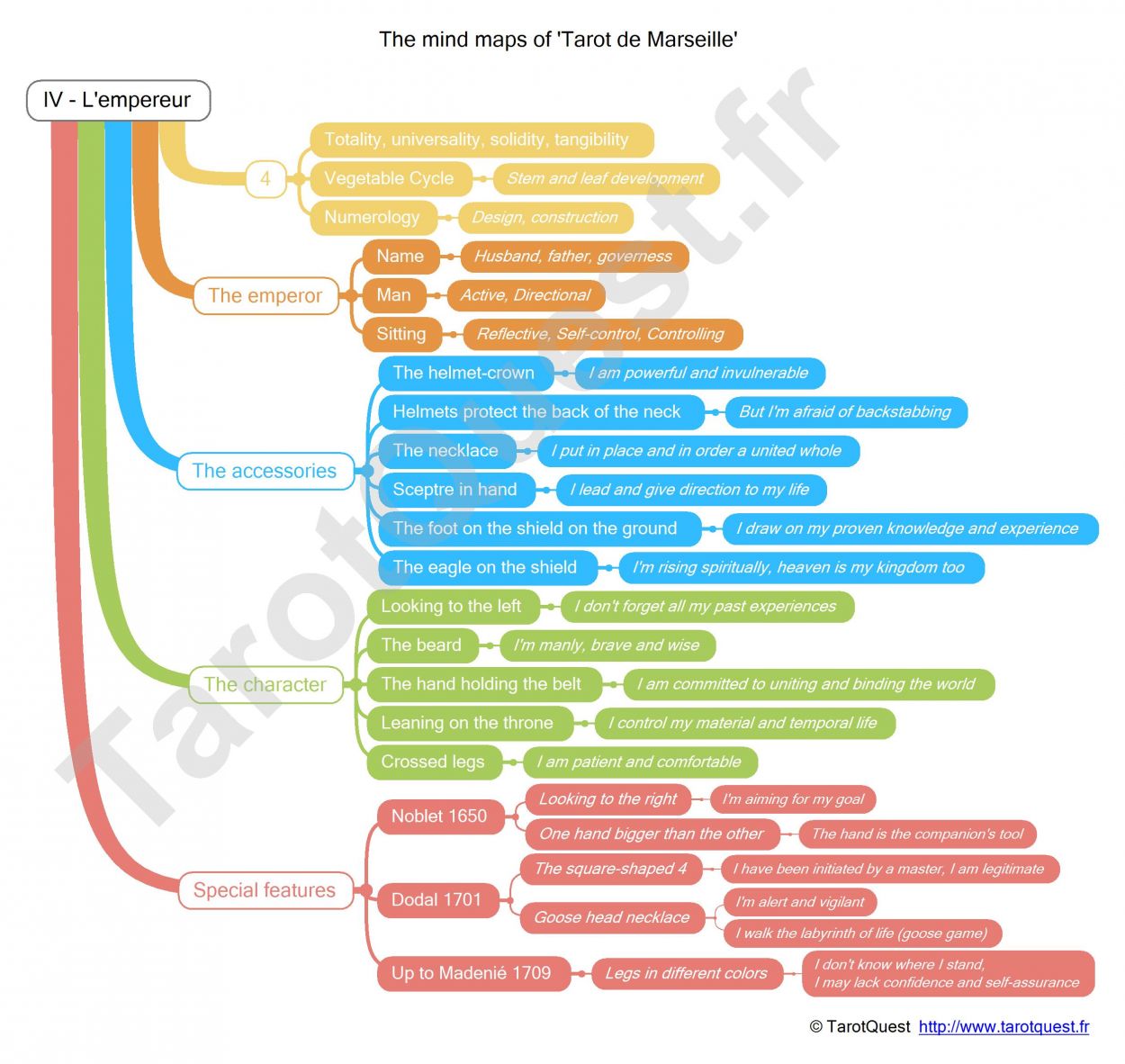

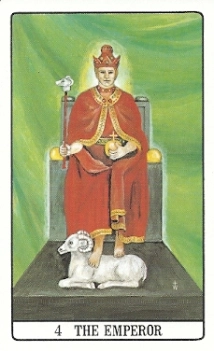
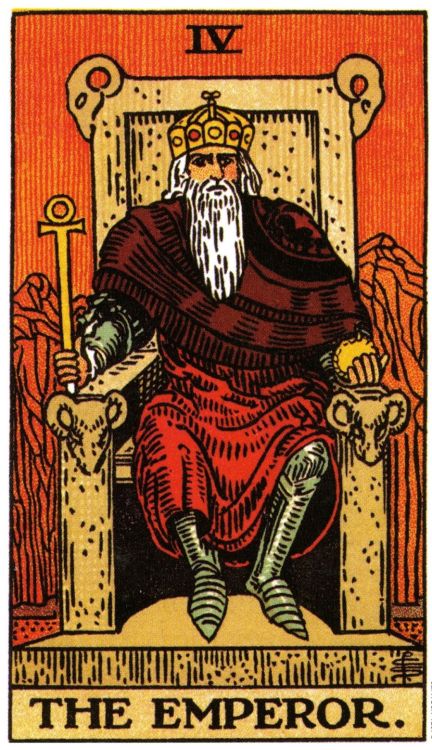

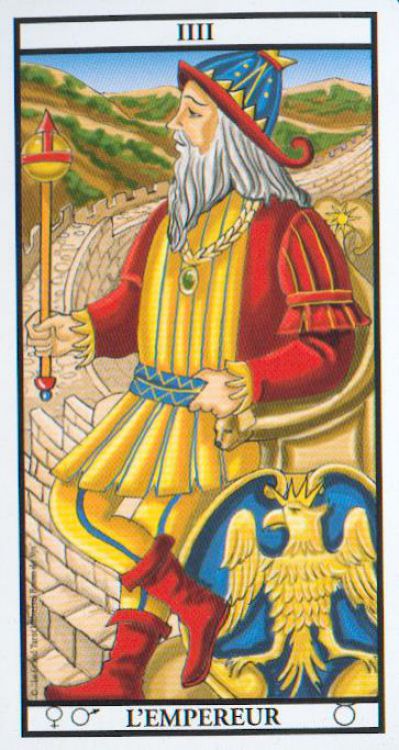
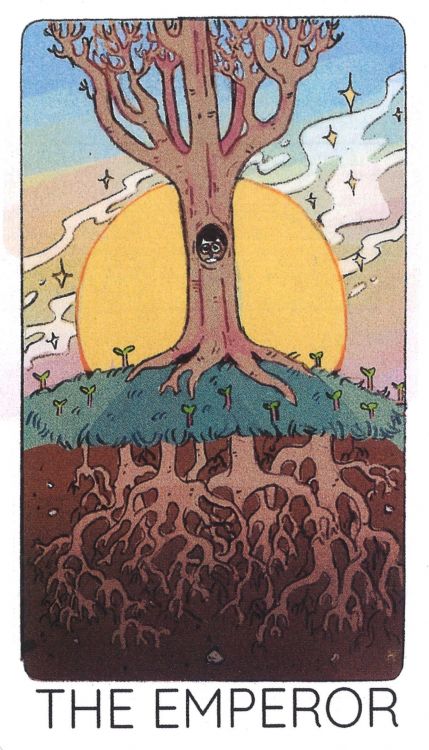
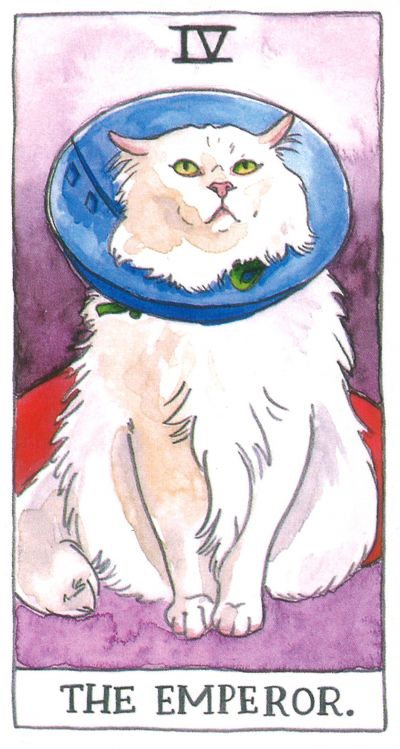

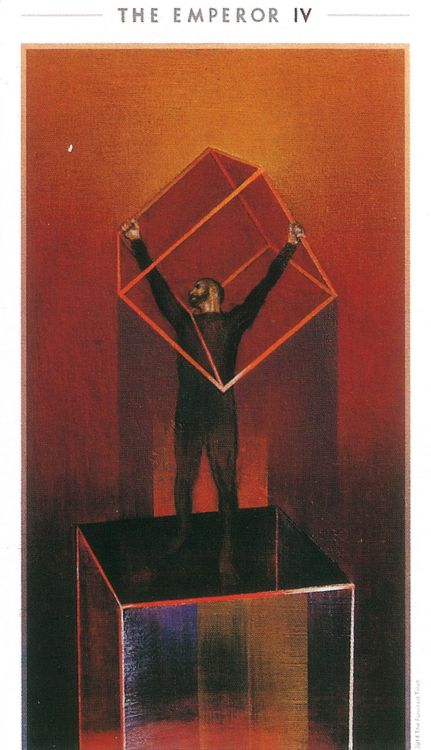
Copyright © TarotQuest.fr